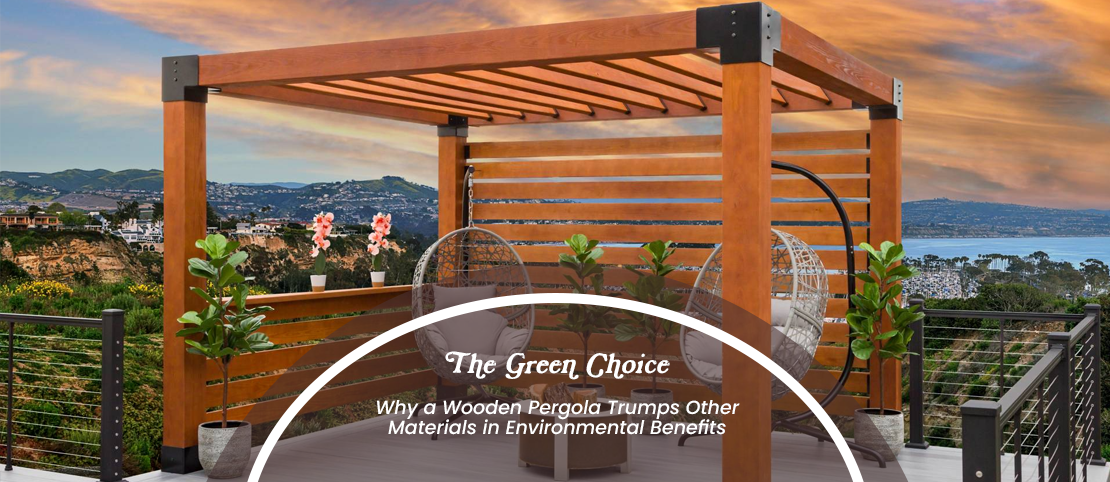Why a Wooden Pergola Trumps Other Materials in Environmental Benefits
Pergolas, with their grace and timeless charm, have been a prominent feature in architectural design for centuries. These wooden structures, often adorned with trailing vines and lush flora, provide both aesthetic appeal and functional purpose. This simple yet elegant outdoor structure not only provides shelter and a sense of tranquility but also offers an eco-friendly option in an era where sustainability is of paramount importance. Opting for a wooden pergola over other materials is a conscious decision that can significantly contribute to a greener planet. In this blog post, we'll delve into the environmental benefits that make wooden pergolas a standout choice.
Origin Of Pergolas
The history of pergolas can be traced back to ancient Egypt, where they were first used. Later on, they became a popular feature of Greek and Roman architecture, and enjoyed renewed interest during the Italian Renaissance. In Asian cultures, pergolas are an essential part of garden design. Nowadays, modern designs combine traditional wooden elements with other building materials to create distinctive and eco-friendly structures.
1. Regenerative and Nature-Derived Material
One of the most significant advantages of wood is that it is a renewable and natural resource making it an environmentally friendly choice. Unlike non-renewable materials such as metal and vinyl, trees can be replanted and harvested sustainably, which can help lower the demand for non-renewable resources and promote sustainable forestry practices. Additionally, for maintaining a healthy forest ecosystem, forestry management can help preserve biodiversity, ensure that new trees are planted to replace those that are harvested, soil quality, and water resources.
2. Degradability in Nature and Environmental Influence
Another noteworthy benefit of wooden pergolas is that they are biodegradable. Unlike metal and vinyl, which can take hundreds of years to decompose and release harmful chemicals into the environment, wooden pergolas naturally decomposes, returning to the environment without leaving a lasting ecological footprint and without causing environmental harm. They can also be repurposed or recycled, which can further minimize their environmental impact.
3. Emissions Impact and Lifecycle Analysis
Wood is a natural insulator, which means that a wooden pergola can help regulate the temperature around the home, reducing the need for heating and cooling systems. Wood has a lower carbon footprint compared to materials like steel or aluminum. This can lead to lower energy usage, resulting in cost savings and a decreased carbon footprint. The process of harvesting, processing, and transporting wood requires less energy and generates fewer emissions. Additionally, during its lifecycle, a wooden pergola continues to store carbon, further reducing its net carbon impact.
4. Reusability and Transformative Use
Wood is an exceptional material that serves many practical purposes. Its unique feature lies in its capability to be recycled and reused for a variety of uses. When a wooden pergola has reached its end of life, it can be transformed into wooden furniture, other structures, or even used as biomass for energy production. This practice is an excellent way to promote a circular economy and minimize waste. By utilizing wood in such a way, we can help preserve resources and reduce our environmental impact.
5. Optimized Thermal Insulation and Energy Performance
It is important to acknowledge that wood has impressive insulation capabilities, making it a highly efficient material for conserving energy. A wooden pergola can help to regulate temperature and reduce the need for additional heating or cooling mechanisms in nearby indoor spaces. Through providing shade and limiting heat absorption, it enables energy savings and a more eco-friendly approach. Incorporating wood into our homes is a great way to achieve the goal of being more environmentally conscious and energy-efficient.
6. Certifications and Practices Promoting Wood Sustainability
The perspective of opting for wooden pergolas made from responsible and sustainably sourced wood is of crucial importance. It is reassuring to be aware of the existence of certifications such as the Forest Stewardship Council (FSC) that can ensure that the wood utilized in products like pergolas is sourced from well-managed forests. By opting for FSC-certified wood, we not only endorse ethical forestry practices but also play a part in safeguarding our environment for future generations.
In summary, opting for a wooden pergola represents a stride towards a future that prioritizes sustainability and environmental awareness in outdoor design. By selecting a material that is natural, renewable, and recyclable, you not only craft a smart and practical outdoor living area but also play a part in conserving our planet for the benefit of future generations. Let us celebrate the allure of wood while championing a more environmentally friendly earth.
Related Posts
By accepting you will be accessing a service provided by a third-party external to https://www.mbt-techserv.com/




